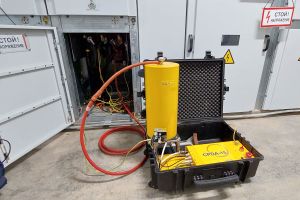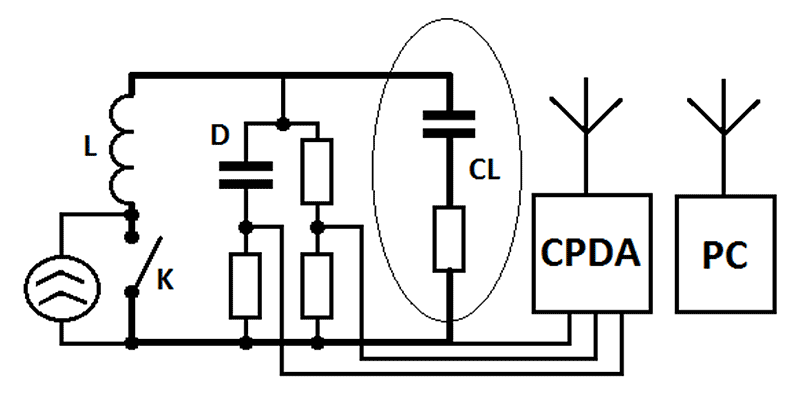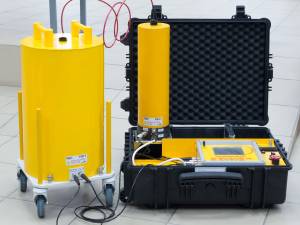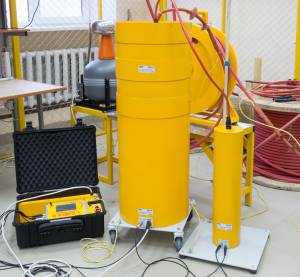CPDA – Cable Insulation Condition Diagnostics by Nondestructive Method

«CPDA» System Advantages:
- Nondestructive insulation diagnostics of cables, joints and terminations;
- Using the most sensitive PD analysis method;
- Defect location in cables;
- Build-in function of dissipation factor measuring in cable insulation;
- Small size because damping AC (DAC) voltage is used;
- The portable system has no analogue in dimensions and cost.
Operating Principles

«CPDA» measuring system is used for effective off-line diagnostics and locating of defects in the insulation by partial discharge measuring and analyzing. It is used for insulation monitoring in all types of high voltage cables. "CPDA" system can be used either for new cables testing, or old cables condition assessment.
"CPDA" portable system consists of a highvoltage unit in the transportation case and a laptop PC.
The high-voltage unit includes:
- A power source with an electronic switch and an inductance coil for generating alternating test voltage.
- A measuring unit, battery and a charger, assembled in one transportation case.
Measuring process is controlled from the PC laptop by WI-FI for safety. PD signals are saved and analyzed on the PC laptop. The data can be viewed and processed in the field during the measurements or later in the office.
Cable Testing
For insulation condition diagnostics, the cable should be charged from the power source for some seconds, until the voltage reaches a definite value, and then discharged to the ground by through the inductance coil.
As a result, resonance arises in the circuit, which consists of the monitored cable capacity and coil inductivity. The monitored cable is influenced by sinusoid damping AC voltage (DAC) with the oscillation frequency from 50 Hz to 1000 Hz, in dependence of the tested object capacity (i.e. the cable length).
The oscillating (damping) voltage influences the tested object for less than 1 second, that's why it has no negative impact on the insulation condition and doesn't damage the cable.
The cables condition is estimated on the basis of PD measuring and analysis results by the expert system «PD-Expert». The following parameters are assessed:
- PD level and activity;
- Voltage of discharge arising;
- Discharge location;
- Insulation defect type;
- Dissipation factor in the insulation.
Analysis and assessment of PD location and parameters allows finding the ways for the cables further service or its replacement.
Modifications of "CPDA" system

«CPDA-15» - 6-10 kV Cable Insulation Condition Diagnostics
- High voltage unit in the transportation case;
- Components in case;
- Calibrator;
- Manual.

«CPDA-30» - up to 20 kV Cable Insulation Condition Diagnostics
- High voltage unit in the transportation case;
- Additional inductivity;
- Components in case;
- Calibrator;
- Manual.

«CPDA-60» - up to 35 kV Cable Insulation Condition Diagnostics
- Measuring unit in the transportation case;
- High voltage unit;
- Additional inductivity (2 pieces);
- Voltage divider;
- Components in case;
- Calibrator;
- Manual.
The «CPDA» system specifications
| CPDA-15 | CPDA-30 | CPDA-60 | |
| Maximum output voltage DC, kV, Peak (RMS) | 18 (12,5) | 28 (20) | 56 (40) |
| Capacity of monitored cable, microFarad (uF) | 0,05 ÷ 10,0 | ||
| Cables charging current, mА | Up to 10 | ||
| Measured PD amplitude range, pC | 10 ÷ 100 000 | ||
| PD measured pulses frequency range, MHz | 0,15 ÷ 50,0 | ||
| DAC frequency range, Hz | 50 ÷ 1000,0 | ||
| «tg d» measuring in the insulation | Yes | ||
| Dimension of CPDA measuring block, mm | 670*520*260 | 670*520*260 | 670*520*260 |
| Weight of CPDA system, kg | 25,0 | 60,0 | 120,0 |
| Operating time from batteries, hours | 4 ÷ 8 | ||
| Supply voltage, V | AC/DC 110÷240 | ||




